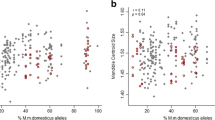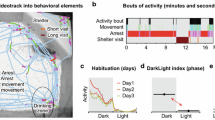Many investigators have attempted to confirm the prediction that increased levels of heterozygosity entail greater developmental stability, manifesting itself through decreased phenotypical variation. The evidence presented so far is equivocal. The predicted relationship has been found in some morphological studies, but not in others. I propose that the variability of a character should be seen as different from the character itself. For most morphological characters, natural selection promotes strong canalization of development but, to facilitate responses to environmental changes, the organism needs to retain malleability of physiological and behavioral traits. These different types of selection should lead to distinct genetic architectures for these phenotypes. I report on the results of a diallel cross between four inbred mouse strains. Qualitatively different genetic architectures were in fact revealed for variation in behaviors in the open-field. In a second study, variances of inbred and hybrid populations for hippocampal morphometry were studied. Again, hybrids were not always less variable than inbreds and sometimes even more variable. It follows that there exists no one-to-one relation between heterozygosity and developmental stability.

Similar content being viewed by others
References
Atchley W. R., Fitch W. M. (1991). Gene trees and the origins of inbred strains of mice. Science 254:554–558
Banbury Conference (1997). Mutant mice and neuroscience: recommendations concerning genetic background. Banbury Conference on genetic background in mice. Neuron 19:755–759
Beacham T. D., Withler R. E. (1985). Heterozygosity and morphological variability of chum salmon (Oncorhynchus keta) in southern British Columbia. Heredity 54:313–322
Broadhurst P. L., Jinks J. L. (1974). What genetical architecture can tell us about the natural selection of behavioural traits. In van Abeelen J. H. F., (eds), The Genetics of Behaviour. North-Holland, Amsterdam
Cohen-Salmon C. (1987). Differences in patterns of pup care in Mus musculus domesticus. VIII. Effects of previous experience and parity in XLII inbred mice. Physiol. Behav. 40:177–180
Crusio W. E. (1987). A note on the analysis of reciprocal effects in diallel crosses. J. Genet. 66:177–185
Crusio W. E. (1990). HOMAL: a computer program for selecting adequate data tranformations. J. Hered. 8:173
Crusio W. E. (1992). Quantitative genetics. In: Goldowitz D., Wahlsten D., Wimer R. E., (eds), Techniques for the Genetic Analysis of Brain and Behavior: Focus on the Mouse, Vol 8. Elsevier, Amsterdam
Crusio W. E. (2000). An introduction to quantitative genetics. In: Jones B. C., Mormède P., (eds), Neurobehavioral Genetics: Methods and Applications. CRC Press, Boca Raton, FL, USA, pp. 1–2
Crusio W. E. (2004). Flanking gene and genetic background problems in genetically manipulated mice. Biol. Psychiatry 56:381–385
Crusio W. E., Genthner-Grimm G., Schwegler H. (1986). A quantitative-genetic analysis of hippocampal variation in the mouse. J. Neurogenet. 3:203–214
Crusio W. E., Kerbusch J. M. L., van Abeelen J. H. F. (1984). The replicated diallel cross: A generalized method of analysis. Behav. Genet. 14:81–104
Crusio W. E., Schmitt A. (1996). Prenatal effects of parity on behavioral ontogeny in mice. Physiol. Behav. 59:1171–1174
Crusio W. E., Schwegler H., van Abeelen J. H. F. (1989a). Behavioral responses to novelty and structural variation of the hippocampus in mice. I. Quantitative-genetic analysis of behavior in the open-field. Behav. Brain Res. 32:75–80
Crusio W. E., Schwegler H., van Abeelen J. H. F. (1989b). Behavioral responses to novelty and structural variation of the hippocampus in mice. II. Multivariate genetic analysis. Behav. Brain Res. 32:81–88
Crusio W. E., van Abeelen J. H. F. (1986). The genetic architecture of behavioural responses to novelty in mice. Heredity 56:55–63
Crusio W. E., van Abeelen J. H. F. (1993). Canalization of behavioral development and heterozygosity in mice. Behav. Genet. 23:550 (abstract)
Danscher G., Zimmer J. (1978). An improved Timm sulphide silver method for light and electron microscopic localization of heavy metals in biological tissues. Histochemistry 55:27–40
Eanes W. F. (1978). Morphological variance and enzyme heterozygosity in the monarch butterfly. Nature 276:263
Fisher R. A. (1958). The Genetical Theory of Natural Selection, 2nd ed. Dover Publications, New York
Fleischer R. C., Johnston R. F., Klitz W. J. (1983). Allozymic heterozygosity and morphological variation in house sparrows. Nature 304:628–630
Handford P. (1980). Heterozygosity at enzyme loci and morphological variation. Nature 286:261–262
Hayman B. I. (1954a). The analysis of variance of diallel tables. Biometrics 10: 235–244.
Hayman B. I. (1954b). The theory and analysis of diallel crosses. Genetics 39:789–809
Henderson N. D. (1981). A fit mouse is a hoppy mouse: jumping behavior in 15-day-old Mus musculus. Dev. Psychobiol. 14:459–472
Henderson N. D. (1989). Genetic influences on behavior of infant Mus domesticus: a comparison of results from diallels derived from single and multiple populations. Behav. Genet. 19:551–574
Hyde J. S. (1973). Genetic homeostasis and behavior: analysis, data, and theory. Behav. Genet. 3:233–245
Jinks J. L. (1954). The analysis of continuous variation in a diallel cross of Nicotiana rustica varities. Genetics 39:767–788
Jinks J. L. (1955). A survey of the genetical basis of heterosis in a variety of diallel crosses. Heredity 9:223–238
Jinks J. L., Hayman B. I. (1953). The analysis of diallel crosses. Maize Genet. News Lett. 27:48–54
Jinks J. L., Mather K. (1955). Stability in development of heterozygotes and homozygotes. Proc. Roy. Soc. Lond. Ser. B Biol. Sci. 143:561–578
Kerbusch S., van der Staay F. J., Hendriks N. (1981). A searching procedure for transformations and models in a classical Mendelian cross breeding study. Behav. Genet. 11:239–254
King D. P. F. (1985). Enzyme heterozygosity associated with anatomical character variance and growth in the herring (Clupea harengus L.). Heredity 54:289–296
Leamy L. (1986). Directional selection and developmental stability: evidence from fluctuating asymmetry of dental characters in mice. Heredity 57:381–388
Leary R. F., Allendorf F. W., Knudsen K. L. (1983). Developmental stability and enzyme heterozygosity in rainbow trout. Nature 301:71–72
Leary R. F., Allendorf F. W., Knudsen K. L. (1984). Superior developmental stability of heterozygotes at enzyme loci in salmon fishes. Am. Nat. 124:540–551
Lerner I. M. (1954). Genetic Homeostasis. Oliver and Boyd, London
Livshits G., Kobyliansky E. (1984). Biochemical heterozygosity as a predictor of developmental homeostasis in man. Ann. Hum. Genet. 48:173–184
Lyon M. F. (2001). X-chromosme inactivation. In: Reeve E.C.R., (eds). Encyclopedia of Genetics. Fitzroy Dearborn, Chicago, IL, USA
McAndrew B. J., Ward R. D., Beardmore J. A. (1986). Growth rate and heterozygosity in the plaice, Plauronectes platessa. Heredity 57:171–180
Mitton J. B. (1978). Relationship between heterozygosity for enzyme loci and variation of morphological characters in natural populations. Nature 273:661–662
O’Keefe J., Nadel L. (1978). The Hippocampus as a Cognitive Map. Clarendon Press, Oxford
Schwegler H., Crusio W. E., Lipp H.-P., Heimrich B. (1988). Water-maze learning in the mouse correlates with variation in hippocampal morphology. Behav. Genet. 18:153–165
Schwegler H., Lipp H.-P. (1983). Hereditary covariations of neuronal circuitry and behavior: correlations between the proportions of hippocampal synaptic fields in the regio inferior and two-way avoidance in mice and rats. Behav. Brain Res. 7:1–38
Soule M. E. (1979). Heterozygosity and developmental stability: another look. Evolution 33:396–401
Strauss S. H. (1987). Heterozygosity and developmental stability under inbreeding and crossbreeding in Pinus attenuata. Evolution 41:331–339
Thoday J. M. (1953). Components of fitness. Symp. Soc. Exp. Biol. 7:96–113
van Abeelen J. H. F. (1963). Mouse mutants studied by means of ethological methods. I. Ethogram. Genetica 34:79–94
Via S., Lande R. (1985). Genotype-environment interaction and the evolution of phenotype plasticity. Evolution 39:505–522
Waddington C. H. (1942). Canalization of development and the inheritance of acquired characters. Nature 150:563–565
Wolfer D. P., Crusio W. E., Lipp H.-P. (2002). Knockout mice: simple solutions to the problems of genetic background and flanking genes. Trends Neurosci. 25:336–340
Zink R. M., Smith M. F., Patton J. L. (1985). Associations between heterozygosity and morphological variance. J. Hered. 76:415–420
ACKNOWLEDGMENTS
I thank Gabi Genthner-Grimm (Heidelberg, Germany) and Herbert Schwegler (Magdeburg, Germany) for their help in collecting the neuroanatomical data. The behavioral data presented in this reanalysis were collected while I was a graduate student in the laboratory of the late Hans van Abeelen (1936–1998), my teacher and mentor, who became my closest friend. Most of the quantitative-genetic analyses were carried out a few years before Hans passed away and I benefited from intensive discussions of the results with him. The Introduction of this article is based on an abstract that we wrote together (Crusio and van Abeelen, 1993). Unfortunately, the writing-up of the final article had to wait several years. If it were not for his untimely death, Hans would certainly have been a co-author of this article, which I dedicate to his memory.
Author information
Authors and Affiliations
Corresponding author
Rights and permissions
About this article
Cite this article
Crusio, W.E. Inheritance of Behavioral and Neuroanatomical Phenotypical Variance: Hybrid Mice Are Not Always More Stable Than Inbreds. Behav Genet 36, 723–731 (2006). https://doi.org/10.1007/s10519-005-9039-2
Received:
Accepted:
Published:
Issue Date:
DOI: https://doi.org/10.1007/s10519-005-9039-2




